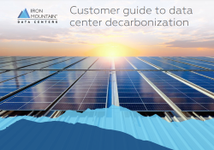I have taken an unusual path to my current role, growing up in Singapore and now based between Amsterdam and Singapore looking after both the EMEA and APAC regions for Iron Mountain Data Centers.
As both regions experience their fastest-ever expansion in data center infrastructure, I thought some readers might be interested in hearing about the key similarities (and differences) between the data center industries in Asia and Europe.
Global growth
The two regions are both growing extremely fast. According to Structure Research, the Asia Pacific data center colocation market accounts for 37 percent of the global market with a forecast five-year CAGR of almost 14 percent.
Over 85 percent of capacity is located in the region’s top six markets. Mainland China dominates with almost half of all capacity, followed by (in order) Japan, Australia, India, Singapore and South Korea.
Europe accounts for 21 percent of the global market with a forecast CAGR of nearly 20 percent. The majority of facilities are in Western Europe, concentrated in the FLAPD markets of Germany, the UK, the Netherlands, France, and Ireland.
Emerging capacity
These days development is power-led, where it used to be connectivity-led, and spillover in search of power is taking place in both Asia and Europe. In Asia, this is predominantly within Southeast Asia. But not everywhere, and the patterns are quite different.
To understand this you need to appreciate that, while Europe can be generally regarded more as a single market, the data center market in Asia is always divided into four distinct regions: China is the largest market by far, and is extremely self-contained. The vast Indian market is also self-contained. Then there are the Southeast Asian and North Asian markets. They all need to be treated separately and have very different internal market dynamics.
There is little to no spillover from the big markets. Mature Indian hubs like Mumbai do not spill over to Singapore, instead, they shift to other Indian hubs like Delhi, Pune, or Bengaluru. In the same way, Shanghai and Beijing tend to expand internally to cities like Guangzhou, Shenzhen, and Chengdu.
Where the spillover happens is within Southeast Asia. Following the Singapore moratorium, development has expanded into three markets – Malaysia, Indonesia, and Thailand. This mirrors the emergence in Europe of new hubs outside the FLAPD regions, in Italy, Spain, Portugal, and Scandinavia.
Sustainability and sovereignty
Here, similarities are emerging because Europe is a role model in both areas. Europe is the most advanced market worldwide in sustainable power sourcing and operation.
As of 2024, half of European power generation was carbon-free, and at least 55 percent of Europe’s current data center power can be mapped to renewables, either indirectly via VPPAs or directly via on-site or on-grid generation.
Asia is catching up fast. It offers abundant solar, wind, and hydropower. By 2030 renewables are expected to make up 30 to 50 percent of the power generation mix in most markets. Countries with the greatest access to renewables are China, Australia, India, and Southeast Asian markets like Vietnam and Laos.
European sustainability regulation is also the most advanced globally. This pays dividends for both Europe and Asia, as the EED (European Energy Directive) is increasingly being used as a model by Asian markets. Most countries also follow Europe on data sovereignty as well as on how you transport power across national borders.
Of course, each country has its own agenda, and implementation across the region is not yet as synchronized as in Europe, but good progress is being made in these areas.
Talent
Workforces in both regions are highly effective. While the industry globally faces a talent gap, I would say this issue is equally relevant in both Europe and Asia. In Asia, just as in Europe, the talent tends to flow from the Tier I markets – these include Singapore, Hong Kong, and Tokyo are the equivalent of London, Frankfurt, and Amsterdam in Europe; home to consultancies and centers of data center expertise.
In both regions you see this talent moving constantly to support and deliver new projects. This is slightly more complicated in Asia due to the huge diversity of national economies. Compensation levels vary significantly, driving constant economically-motivated movement of people across borders.
Business borders
There are clear similarities, and in the globalized, standardized, and hugely investable data center business, it may be tempting to see the world as one homogeneous market. However, in terms of doing business, the differences between Europe and Asia are huge.
When you say Europe you think of the European Union, and you think of the Euro: a central body managing shared standards and a shared currency. While there are different countries and different cultures, there is a lot in common. Asia is not like that.
The difference between countries is far greater and more immediate. You need a passport, you have to work with currency controls, and you need to adopt entirely new business practices. For instance, there is a big difference between the Netherlands and Germany but it is not on the same scale as the difference between, say, Singapore and Malaysia.
Over and above national borders, Asia has a very different business culture. In Europe people are more direct, they just say and ask what’s on their mind. This is not the case in Asia, where relationship building and the slow development of trust are more critical factors. If I call a Town Hall in Asia I hardly get any questions. In Europe I always get lots.
These factors can have a major impact on the way we do business in Asia Pacific as opposed to Europe. When we look at new markets there are some we can approach on our own and are relatively straightforward. In others, where you need to be connected to get connected, we need local partners to negotiate the political, economic, and cultural landscape.
Power and pricing
For an investor, cost, and pricing are probably the biggest differences. Construction costs in low labor cost markets in Asia can generally be lower than in Europe. So are utility costs, one of the key drivers of growth, for instance in Malaysia. India has also always been competitive compared to other countries and is extremely price-sensitive.
In Europe, power pricing can fluctuate, but this is on the basis of predictable factors. While power can be very cheap in Asia, the quality of transmission varies and future costs are harder to predict.
Power is entirely controlled by the government, and no matter how much the industry wants to collaborate across borders, they must follow their government’s lead.
While there is significant investment in new power generation and transmission, how this will translate to end-users is less clear compared to Europe.
Scale
The other huge differentiating factor is scale. For people operating exclusively in the European or North American markets it can be difficult to appreciate the scale of the challenges – and the opportunities – in Asia Pacific, which now (excluding China) accounts for over 40 percent of world GDP and rising fast.
Asia Pacific’s population (again excluding China) is nearly three billion compared to Europe’s population of 743 million. The region is also the biggest driver of global economic growth, accounting for the majority of GDP growth in the last decade. Another way of putting this is that Asia is the biggest medium-term market opportunity in the world.
Conclusion: From local to global
In our business, Asia Pacific and Europe share common ground, common customers, and common challenges. The search for plentiful low-carbon power is probably the strongest similarity, and this will shape the future of both markets. The additional layer of political and cultural complexity in Asia is probably the biggest difference.
Despite that there is more risk to be taken, the growth opportunities are significant in the region. Strategic planning and partnerships are the key to success. Developers and operators cannot just walk in and point at what they want, they need local contacts, local expertise, and strong relationships.
This needs to be balanced with a global forward-looking perspective that is friendly to some of the world’s largest and most demanding and knowledgeable customers.
The good thing about working as I do for a global operator like Iron Mountain Data Centers is that we have clear enforced and certified standards that operate on a global level. The customers appreciate the effort this takes. And we have talent that we can move around from region to region as new opportunities emerge, something which does not just go west to east, it goes east to west as well.
More from Iron Mountain

Sponsored
Site selection in a shifting landscape
How advanced cloud services, growing levels of content, and new AI applications are simultaneously providing opportunities to deliver new scalable locations while creating challenges for supply

Customer guide to data center decarbonization
The key steps in the route to total decarbonization

Read the orginal article: https://www.datacenterdynamics.com/en/opinions/where-east-meets-west/


